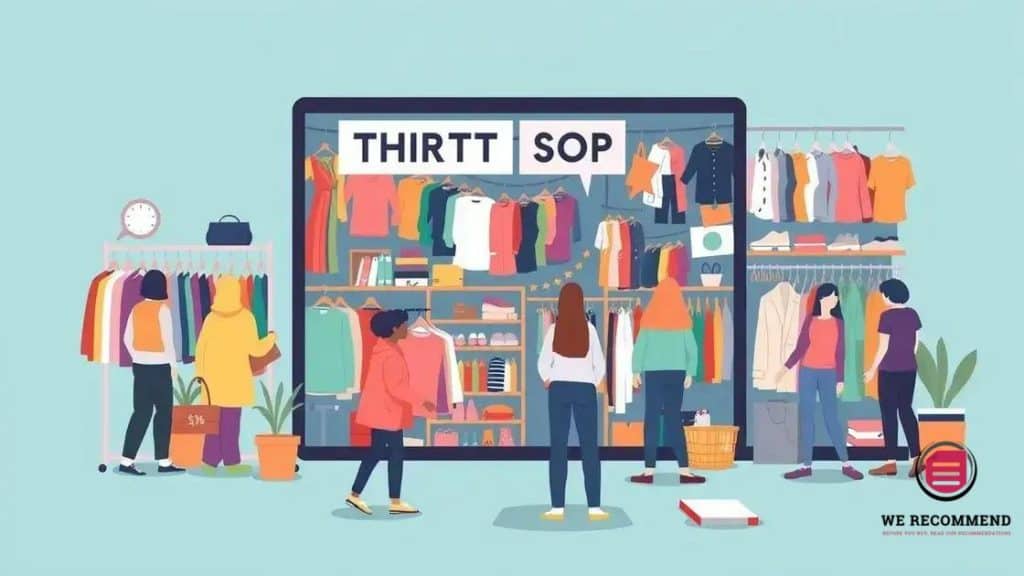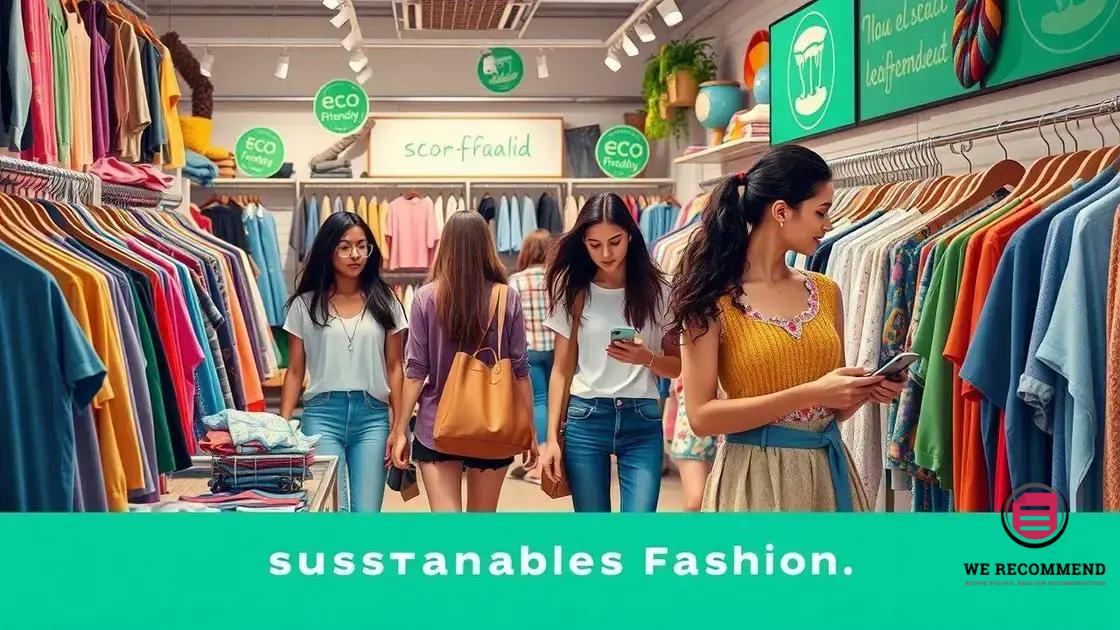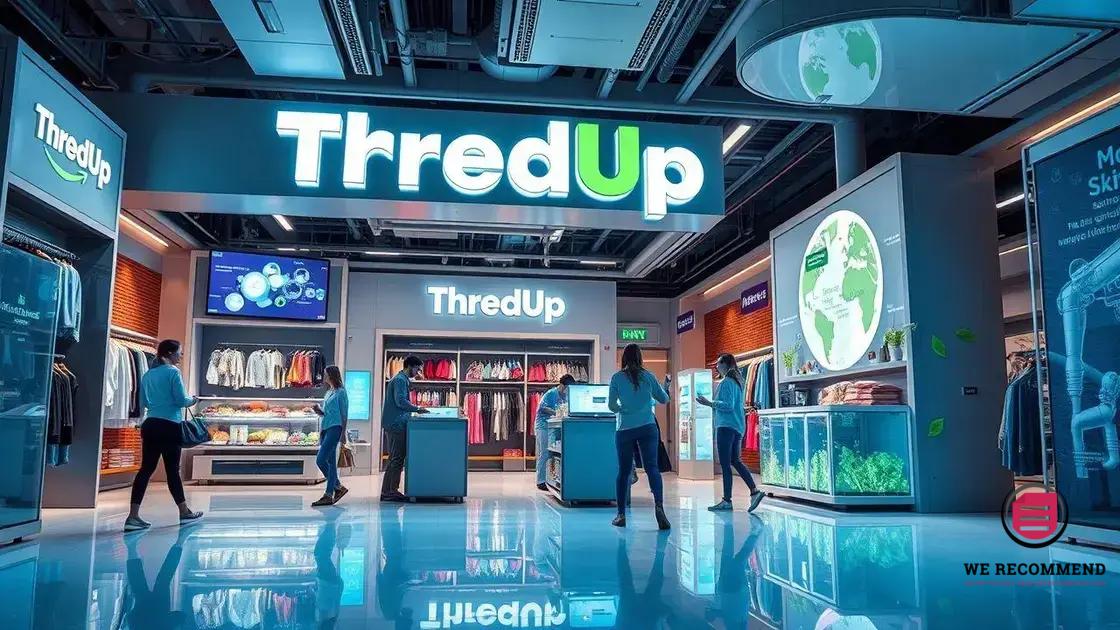ThredUp growth 2025: what to expect in the used fashion market

Anúncios
ThredUp’s growth by 2025 is driven by technological innovations, increased consumer interest in sustainable fashion, and effective strategies that enhance the user experience and expand its market presence in the resale industry.
ThredUp growth 2025 is set to redefine the online secondhand apparel market. With sustainability in focus, many consumers are shifting toward thrift shopping. How will this impact the future of ThredUp?
Anúncios
Understanding ThredUp’s business model
ThredUp operates as a leading online consignment and thrift store, focusing on sustainable fashion. Customers can send their gently used clothing to ThredUp for sale, promoting a circular economy.
Anúncios
This model not only helps consumers declutter but also offers an affordable option for shoppers seeking quality secondhand clothing.
The Process of Selling
To sell on ThredUp, users simply order a cleanout kit, fill it with their unwanted clothes, and send it back. ThredUp then takes care of the rest, including:
- Sorting and inspecting the items for quality.
- Taking professional photos and listing them on the site.
- Handling pricing and shipping to the buyers.
This approach allows sellers to earn money while enabling ThredUp to curate a diverse inventory.
For more information about ThredUp’s consignment process and how it benefits consumers, visit their official site at ThredUp.
Market trends impacting ThredUp
Market trends play a crucial role in shaping the future of ThredUp. As sustainability becomes a priority for many consumers, the demand for secondhand clothing is increasing.
One major trend is the growing awareness of the environmental impact of fast fashion. Consumers are opting for brands that promote eco-friendly practices, making resale platforms like ThredUp increasingly popular.
Key Trends to Watch
- Rise of Eco-Conscious Shopping: More shoppers are looking for sustainable options, driving traffic to resale websites.
- Digital Shopping Habits: As online shopping continues to grow, ThredUp’s user-friendly platform helps attract tech-savvy consumers.
- Influence of Social Media: Social platforms are changing how consumers discover thrift items, with influencers showcasing secondhand clothing.
Additionally, ThredUp benefits from collaborations with other brands, enhancing its visibility and attractiveness. For a deeper exploration of market trends, check out articles on platforms like Forbes.
ThredUp’s strategies for growth
ThredUp’s growth strategies focus on expanding its market reach and enhancing customer experience. By integrating technology and sustainable practices, ThredUp stands out in the thrift industry.
One pivotal strategy is improving the user interface of their online platform. This makes shopping easier and more enjoyable for customers.
Key Strategies for Expansion
- Diverse Product Offerings: ThredUp continuously adds new brands and categories to attract a wider audience.
- Marketing Campaigns: Engaging social media campaigns and influencer partnerships help raise awareness of ThredUp’s mission and sales.
- Partnerships: Collaborating with established brands boosts credibility and expands inventory.
Additionally, ThredUp is investing in technology to enhance personalization in shopping experiences. For insights into their growth potential, explore reports on Business Insider.
Consumer behavior in the resale market

Understanding consumer behavior in the resale market is essential for companies like ThredUp. Shoppers today are increasingly drawn to thrift shopping for various reasons, including affordability and sustainability.
Many consumers view purchasing secondhand items as a way to reduce their environmental impact. This shift has led to a growing customer base that prioritizes eco-friendly practices.
Reasons for Choosing Resale
- Cost Savings: Buying used clothing is often cheaper than new, making it attractive for budget-conscious shoppers.
- Sustainability: Many consumers seek to support brands that promote recycling and reduce waste.
- Unique Finds: Resale markets provide unique, one-of-a-kind items that cannot be found in traditional retail.
Additionally, younger shoppers, such as millennials and Generation Z, are more likely to engage in resale shopping. These groups often rely on social media for fashion inspiration and discover resale options through influencers. To dive deeper into consumer behavior patterns, visit Statista.
Environmental impact of thrift shopping
Thrift shopping has a significant positive impact on the environment. By choosing secondhand items, consumers help reduce waste and decrease the demand for fast fashion.
Every year, millions of clothing items end up in landfills, contributing to pollution and resource depletion. Thrift shopping offers a sustainable alternative.
Benefits of Thrift Shopping
- Reduces Waste: Buying used clothing keeps garments out of landfills.
- Conserves Resources: Secondhand shopping minimizes the need for new materials, saving water and energy in production.
- Promotes Recycling: Thrift stores give clothing a second life, which encourages a circular economy.
Moreover, many thrift shops support charitable causes, making purchases impactful in more ways than one. To learn more about the environmental benefits of thrift shopping, check out resources from Earth Day Network.
Challenges ThredUp may face
ThredUp faces several challenges in the competitive thrift market. As consumer interest in secondhand shopping rises, they must adapt to changing market conditions.
One major challenge is maintaining quality control. With numerous items coming in, it is essential for ThredUp to ensure that every piece meets their standards.
Key Challenges Ahead
- Inventory Management: Balancing incoming products with consumer demand requires efficient systems.
- Brand Competition: New resale platforms are emerging, increasing competition for ThredUp.
- Economic Factors: Changes in the economy can affect consumer spending habits, impacting sales.
Additionally, ThredUp has to continuously engage with customers through effective marketing strategies. For insights into industry challenges, visit Forbes.
Technological innovations within ThredUp
Technological innovations play a vital role in enhancing ThredUp’s operations and customer experience. As a leader in the resale market, ThredUp leverages technology to streamline processes and improve accessibility.
One significant innovation is their advanced inventory management system, which helps keep track of items efficiently.
Innovative Technologies at ThredUp
- AI-Powered Algorithms: These algorithms assist in pricing items based on demand and condition, ensuring fair pricing for consumers.
- User Experience Enhancements: ThredUp continuously updates its website and app for easier navigation and a better shopping experience.
- Sustainability Tracking: Technology allows ThredUp to measure and promote the environmental impact of shopping secondhand.
These tech initiatives not only improve ThredUp’s efficiency but also reinforce their commitment to sustainability. For more insights into technological advancements in retail, check out Retail Dive.
Future predictions for ThredUp by 2025

Future predictions for ThredUp by 2025 indicate significant growth and innovation in the resale market. As more consumers embrace secondhand shopping, ThredUp is expected to expand its customer base and inventory.
One potential trend is the increased integration of technology to enhance user experience, making shopping easier and more efficient.
Possible Developments by 2025
- Enhanced AI Features: ThredUp may implement advanced AI to provide personalized shopping experiences and better inventory management.
- Expansion of Partnerships: Collaborations with other brands could help increase product offerings and visibility.
- Sustainability Initiatives: ThredUp is likely to promote its environmental impact more aggressively, appealing to eco-conscious consumers.
These factors may position ThredUp as a leader in the sustainable fashion space. For more insights into future trends in retail, visit McKinsey & Company.
In summary, the future of ThredUp looks bright
With the growing trend of sustainable fashion and the increasing popularity of secondhand shopping, ThredUp is well-positioned for significant growth.
Embracing technology and focusing on consumer behavior will be key strategies for success. By investing in innovations and partnerships, ThredUp can enhance customer experiences and continue to lead in the resale market.
As we move toward 2025, the focus on sustainability and unique shopping experiences will likely draw even more shoppers to ThredUp, reinforcing its status as a leader in the industry.
FAQ – Frequently Asked Questions about ThredUp’s Growth and Innovations
What factors contribute to ThredUp’s growth in the resale market?
ThredUp’s growth is driven by the increasing demand for sustainable fashion, technological innovations, and effective marketing strategies.
How does ThredUp ensure quality control of its products?
ThredUp uses a comprehensive inventory management system to inspect and assess each item before listing it for sale, ensuring high-quality products.
What technological advancements is ThredUp implementing?
ThredUp is integrating AI and improving user experience on its platform to enhance personalized shopping and inventory management.
How does ThredUp promote sustainability in its business model?
ThredUp focuses on recycling and reducing waste by encouraging consumers to shop secondhand, which lowers the demand for new clothing production.






